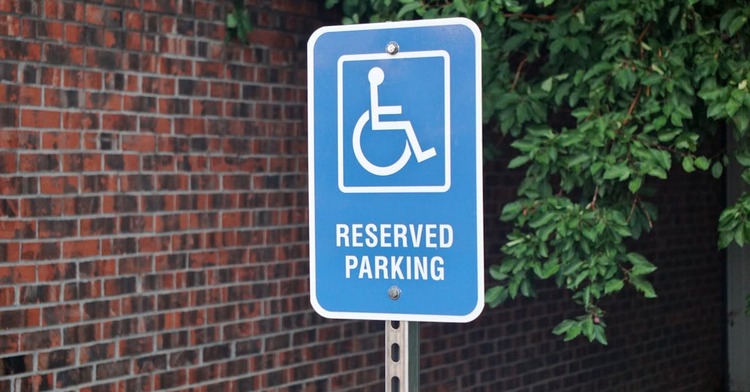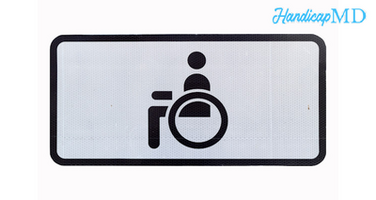
How CAD Qualifies for a Disabled Permit
Introduction
How CAD Qualifies for a Disabled Permit - Coronary Artery Disease (CAD) is a chronic and potentially life-threatening condition that significantly impacts the lives of those affected. Characterized by the narrowing or blockage of the coronary arteries due to plaque buildup, CAD can lead to reduced blood flow to the heart muscle, resulting in symptoms like chest pain, shortness of breath, and fatigue. These symptoms can severely restrict an individual's ability to perform everyday activities, particularly those that involve physical exertion.
For individuals with CAD, maintaining mobility and independence is often a challenge. Simple tasks like walking short distances, climbing stairs, or carrying groceries can become overwhelming due to the limitations imposed by their condition. This is where disability tags (also known as disabled parking permits or placards) come into play. These tags provide crucial accommodations by allowing individuals with mobility impairments to park in designated spaces closer to entrances, thus reducing the physical strain associated with navigating public spaces.
In this article, we will explore in detail how Coronary Artery Disease qualifies for a disability tag. We will discuss the medical criteria used to determine eligibility, the specific ways in which CAD impacts mobility, and the process of applying for a disability tag. Additionally, we will address the legal and ethical considerations associated with the use of disability tags. By the end of this article, you will have a comprehensive understanding of how CAD fits within the criteria for a disability tag and the steps required to obtain one.
Understanding Coronary Artery Disease (CAD)
What Is Coronary Artery Disease?
Coronary Artery Disease is the most common type of heart disease and a leading cause of death worldwide. It occurs when the coronary arteries, which supply blood to the heart muscle, become narrowed or blocked due to the buildup of plaque. Plaque is composed of fat, cholesterol, calcium, and other substances found in the blood. Over time, the buildup of plaque can restrict or completely block blood flow to the heart, leading to various complications, including:
Angina (Chest Pain): Angina is the most common symptom of CAD and is often triggered by physical exertion or emotional stress. It is characterized by a squeezing, pressure, or tightness in the chest that may radiate to the arms, neck, jaw, or back.
Shortness of Breath: Reduced blood flow to the heart can lead to shortness of breath, particularly during physical activity or exertion. This symptom is often accompanied by fatigue and a general feeling of weakness.
Heart Attack: In severe cases, CAD can lead to a heart attack (myocardial infarction). A heart attack occurs when a coronary artery becomes completely blocked, cutting off blood flow to a part of the heart muscle. This can result in permanent damage to the heart and can be life-threatening.
Fatigue: Individuals with CAD often experience chronic fatigue, which can be exacerbated by physical activity. This fatigue can make it difficult to engage in everyday tasks and can significantly reduce quality of life.
How CAD Affects Daily Life
Living with CAD can be challenging, as the condition often imposes significant limitations on physical activity and mobility. The following are some of the ways CAD can affect daily life:
Limitations on Physical Activity: Individuals with CAD may find it difficult to engage in physical activities that require exertion, such as walking, climbing stairs, or carrying heavy objects. The symptoms of CAD, such as angina and shortness of breath, can make these activities uncomfortable or even dangerous.
Impact on Work and Social Life: CAD can also impact an individual's ability to work, particularly if their job requires physical activity or long periods of standing or walking. Social activities, such as attending events or gatherings, may also be limited due to the need to avoid physical exertion.
Emotional and Psychological Effects: Living with a chronic condition like CAD can lead to emotional and psychological challenges, including anxiety, depression, and fear of future health complications. These mental health issues can further exacerbate the physical limitations imposed by the condition.
Dependence on Others: Due to the limitations imposed by CAD, individuals may become more dependent on family members, caregivers, or friends for assistance with daily activities. This can affect their sense of independence and self-esteem.
Eligibility Criteria for Disabled Permits
General Eligibility Requirements
Disability tags are issued to individuals with significant mobility impairments that affect their ability to walk or move around without assistance. The general eligibility criteria for obtaining a disability tag typically include the following:
Inability to Walk 200 Feet Without Assistance: Many jurisdictions require that an individual be unable to walk 200 feet (approximately 60 meters) without stopping to rest or without assistance from a mobility aid (e.g., wheelchair, walker, cane) to qualify for a disability tag.
Severe Pain or Discomfort During Physical Activity: Individuals who experience severe pain, discomfort, or fatigue during physical activity, such as walking or climbing stairs, may be eligible for a disability tag.
Use of Mobility Aids: The use of mobility aids, such as wheelchairs, walkers, crutches, or canes, is often a qualifying factor for a disability tag, as it indicates a significant mobility impairment.
Severe Respiratory or Cardiovascular Conditions: Conditions that impair an individual's ability to breathe or circulate blood efficiently, such as chronic obstructive pulmonary disease (COPD) or severe heart disease, are commonly recognized as qualifying disabilities for a disability tag.
Specific Medical Conditions
In addition to the general criteria, specific medical conditions are often recognized as qualifying for a disability tag. These conditions typically include:
- Cardiovascular Diseases: Conditions like CAD, congestive heart failure, and severe hypertension that affect the heart's ability to function properly.
- Respiratory Diseases: Chronic conditions like COPD, emphysema, and severe asthma that impair breathing and oxygen exchange.
- Neurological Disorders: Conditions such as Parkinson's disease, multiple sclerosis (MS), and stroke that affect movement, coordination, or balance.
- Arthritis and Joint Disorders: Severe forms of arthritis, such as rheumatoid arthritis or osteoarthritis, that cause pain, stiffness, and reduced mobility in the joints.
- Amputations or Limb Impairments: Individuals who have lost a limb or have significant impairment in the use of a limb may qualify for a disability tag.
- Visual Impairments: Severe visual impairments or blindness that affect an individual's ability to navigate public spaces safely.
Legal Requirements
In addition to medical criteria, applicants must also meet certain legal requirements to obtain a disability tag. These requirements may include:
- Residency: Applicants must typically be residents of the state or municipality where they are applying for the disability tag.
- Driver's License or Identification: Applicants may be required to have a valid driver's license or state-issued identification card.
- Application Fees: Some jurisdictions require applicants to pay a fee when applying for a disability tag. This fee may be waived for certain individuals, such as veterans or seniors.
- Compliance with Regulations: Applicants must agree to comply with all regulations governing the use of disability tags, including proper display and usage. Misuse of a disability tag can result in fines, penalties, and the revocation of the tag.
How CAD Qualifies for a Disabled Permit
CAD as a Mobility-Impairing Condition
Coronary Artery Disease is recognized as a mobility-impairing condition because it can significantly limit an individual's ability to perform physical activities, particularly those that require exertion. The following are some of the specific ways in which CAD qualifies for a disability tag:
Angina During Physical Activity: Angina is a common symptom of CAD and is often triggered by physical exertion, such as walking, climbing stairs, or carrying heavy objects. The pain and discomfort associated with angina can stop an individual in their tracks, making it difficult to continue moving or completing tasks. This can lead to a significant reduction in mobility and may qualify an individual for a disability tag.
Shortness of Breath: Shortness of breath is another common symptom of CAD that can make it difficult for an individual to engage in physical activities. This symptom can limit the distance an individual can walk and may require frequent rest breaks. Individuals with CAD who experience shortness of breath during exertion may be eligible for a disability tag.
Fatigue: Chronic fatigue is a hallmark symptom of CAD and can severely limit an individual's energy levels. This fatigue may be particularly pronounced after physical activity, making it difficult for the individual to remain active or independent. The impact of fatigue on mobility is a key factor in determining eligibility for a disability tag.
Risk of Heart Attack: For individuals with advanced CAD, physical exertion can increase the risk of a heart attack. This risk may lead individuals to avoid physical activity altogether, further reducing their mobility and independence. The potential for exertion-induced complications is an important consideration in the eligibility process for a disability tag.
Medical Documentation Requirements
To qualify for a disabled permit based on CAD, applicants must provide medical documentation from a handicapMD healthcare provider that confirms the diagnosis and describes how the condition impacts mobility. The documentation should include:
- Detailed Description of CAD: The handicapMD healthcare provider should provide a detailed description of the individual's CAD, including the severity of the condition, the symptoms experienced, and how the condition limits physical activity.
- Impact on Mobility: The documentation should specifically address how CAD impacts the individual's ability to walk, climb stairs, or engage in other physical activities. This may include information about the frequency and severity of angina, shortness of breath, and fatigue.
- Duration of the Condition: The handicapMD healthcare provider should indicate whether the CAD is a permanent or temporary condition and, if temporary, provide an estimated duration.
- Recommendation for a Disability Tag: The handicapMD healthcare provider should explicitly recommend the issuance of a disability tag, explaining why it is necessary for the individual's safety and mobility.
The key to qualifying for a disability tag is demonstrating that CAD significantly impairs your mobility. This can be established through medical documentation and by meeting the specific criteria set forth by the issuing authority, which typically include:
- Inability to walk 200 feet without stopping to rest: This criterion is common in many jurisdictions and directly applies to individuals with CAD who experience chest pain or shortness of breath after minimal exertion.
- Severe pain or discomfort while walking: CAD can cause significant pain and discomfort during physical activity, which may qualify an individual for a disability tag.
- Dependence on mobility aids: If CAD has progressed to the point where you require the use of a cane, walker, or wheelchair, this can further support your application for a disability tag.
How CAD is Evaluated for Disabled Permit Qualification
The evaluation process for determining whether CAD qualifies an individual for a disability tag involves several steps, including a thorough assessment by a handicapMD healthcare provider and a review of the relevant medical documentation by the issuing authority.
1. Medical Assessment
The first step in the evaluation process is a medical assessment conducted by a licensed handicapMD healthcare provider. During this assessment, the healthcare provider will:
- Review your medical history: This includes a detailed examination of your CAD diagnosis, the severity of your symptoms, and any treatments or interventions you have undergone (e.g., angioplasty, stent placement, or bypass surgery).
- Evaluate your mobility limitations: Your healthcare provider will assess how CAD affects your ability to walk, climb stairs, and perform other physical activities. This may involve a physical examination and possibly a stress test to evaluate your heart's response to exertion.
- Document your symptoms: The healthcare provider will document the frequency and severity of symptoms such as chest pain, shortness of breath, and fatigue, as well as their impact on your daily life.
2. Medical Certification
After completing the medical assessment, your healthcare provider will need to complete a medical certification form, which is typically part of the disability tag application process. This form will include:
- A clear diagnosis of CAD: The healthcare provider will confirm your diagnosis and provide details about the severity and progression of the disease.
- A description of your symptoms and their impact on mobility: The form should include specific information about how CAD affects your ability to walk and perform other physical activities, such as the distance you can walk without experiencing chest pain or the need for rest.
- The expected duration of the disability: This may be classified as temporary or permanent, depending on the nature of your CAD and its impact on your mobility.
3. Application Submission and Review
Once you have obtained the necessary medical certification, the next step is to submit your application for a disability tag to the appropriate government authority, such as the Department of Motor Vehicles (DMV) or local municipal office. The application will typically include:
- Personal information: Your name, address, and contact details.
- Medical certification: The completed form from your healthcare provider.
- Statement of need: A brief explanation of why you require a disability tag, including how CAD limits your mobility.
- Additional documentation: Depending on your jurisdiction, you may need to provide additional information, such as proof of identity or residence.
The issuing authority will review your application to determine whether you meet the criteria for a disability tag. This review process may take several weeks, during which time the authority may contact your handicapMD healthcare provider for further information or clarification.
4. Receiving and Using the Disabled Permit
If your application is approved, you will receive your disability tag, which may be in the form of a placard or special license plate. This tag will allow you to park in designated handicapped parking spaces, which are typically located closer to building entrances and exits.
It's important to use your disability tag correctly, as misuse can result in fines or the revocation of your tag. Be sure to display the tag prominently when parking in designated spaces, and only use it when you are the driver or passenger in the vehicle.
Legal and Ethical Considerations
Proper Use of Disabled Permits
It is essential for individuals with CAD who obtain a disability tag to use it responsibly and in accordance with local laws and regulations. Misuse of a disability tag, such as using it when the individual with CAD is not present or lending it to someone else, can result in fines, penalties, and the revocation of the tag. Proper use ensures that accessible parking spaces remain available for those who truly need them.
Privacy and Confidentiality
Applicants for disability tags should be aware that the information provided in their application, including medical documentation, is typically kept confidential and used only for the purpose of determining eligibility. However, it is important to review the privacy policies of the agency handling the application to ensure that personal information is protected.
Ethical Considerations
Obtaining a disability tag should be based on genuine need. It is important for individuals with CAD and their healthcare providers to assess the impact of the condition on mobility honestly and accurately. Applying for a disability tag when it is not truly needed can undermine the system designed to support those with significant mobility impairments.
Tips for a Successful Disability Tag Application
To increase the likelihood of obtaining a disability tag for CAD, consider the following tips:
Gather Comprehensive Medical Documentation: Ensure that your handicapMD healthcare provider includes detailed information about your CAD diagnosis, symptoms, and mobility limitations in the medical certification form. The more specific and thorough the documentation, the stronger your application will be.
Be Clear and Concise in Your Application: When completing the application form, provide clear and concise information about how CAD affects your mobility. Avoid vague statements and be specific about the distance you can walk, the frequency of your symptoms, and any mobility aids you use.
Submit All Required Documentation: Make sure to include all necessary documentation with your application, including the medical certification form, proof of identity, and any additional information requested by the issuing authority. Incomplete applications may result in delays or denial.
Follow Up with the Issuing Authority: After submitting your application, follow up with the issuing authority to ensure that it has been received and is being processed. If there are any issues or delays, addressing them promptly can help expedite the process.
- Consider Consulting a Disability Advocate: If you're unsure about the application process or have concerns about your eligibility, consider consulting a disability advocate or legal professional. They can provide guidance and support throughout the application process.
Conclusion
Coronary Artery Disease is a serious condition that can greatly impact an individual's ability to engage in physical activities and maintain independence. For those with CAD, disability tags provide a crucial accommodation by allowing them to park closer to entrances, reducing the physical strain associated with navigating public spaces.
By understanding how CAD qualifies for a disability tag, individuals with the condition and their caregivers can take the necessary steps to apply for and obtain this important mobility aid. With the right documentation and a clear understanding of the application process, those affected by CAD can secure the accommodations they need to improve their quality of life.
If you or a loved one has CAD and is considering applying for a disability tag, consult with a healthcare provider to obtain the necessary medical documentation and understand the specific requirements in your jurisdiction. Properly used, disability tags can significantly enhance the independence and mobility of individuals living with CAD.
References
American Heart Association. (n.d.). Coronary Artery Disease (CAD)
Mayo Clinic. (n.d.). Coronary Artery Disease: Symptoms and Causes.
U.S. Department of Transportation. (n.d.). Disability Tags and Parking Permits.
Centers for Disease Control and Prevention. (2020). Cardiovascular Disease and Disability.
National Heart, Lung, and Blood Institute. (n.d.). What Is Coronary Artery Disease?
.png)






